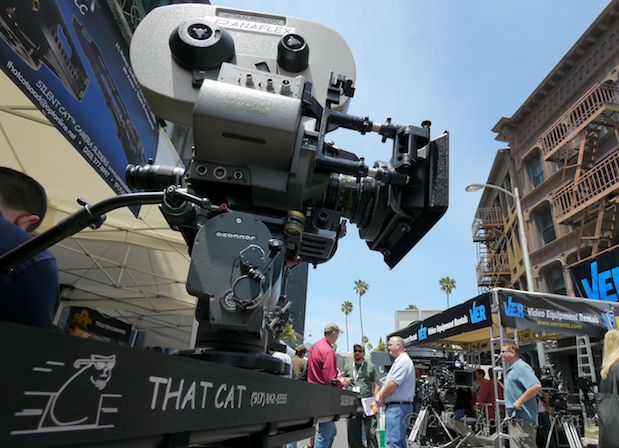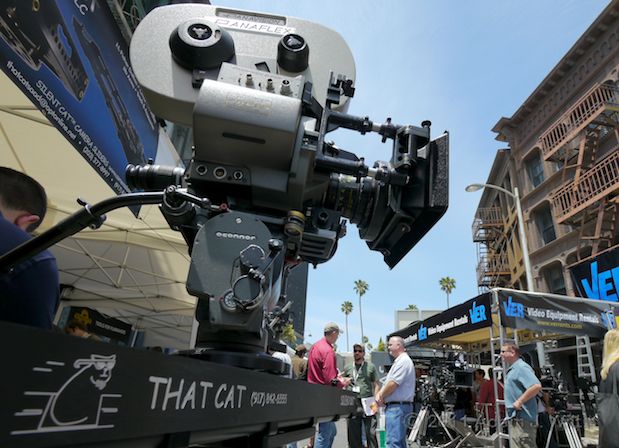
A Panaflex on a Silent Cat slider? It must be Cine Gear Expo time!
Cine Gear Expo, “the film, video, and digital expo with focus”, offered the usual kid-in-a-candy-store experience, and introduced new light-emitting plasma (LEP) instruments, new cameras, and a revolutionary new electronic shuttering device that gives digital cameras better motion portrayal capabilities than even the best mechanically-shuttered film or digital camera. [Updated 2011-06-11: removed erroneous “12 Hz” shutter rate reference.]
First, though, the obligatory beauty shots, for those unable to attend…
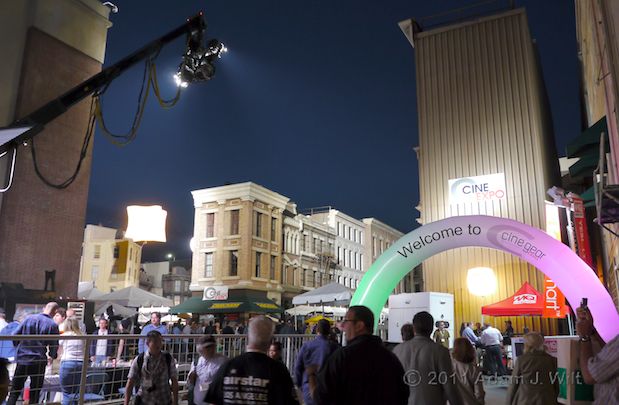
Welcome to Cine Gear. MultiQuip H2LT on the right (details below).
Cine Gear Expo was held at Paramount Studios in Hollywood, from 4-10pm on Friday and 10am-5pm Saturday. Outdoor exhibits filled the “New York Street” backlot at Paramount; Stages 17 and 18 held indoor booths, and seminars took place in various theaters, screening rooms, and offices at Paramount.
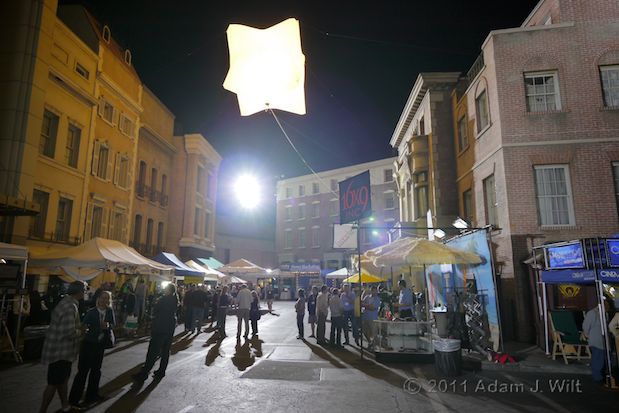
Balloon lights and lighting towers keep it bright…
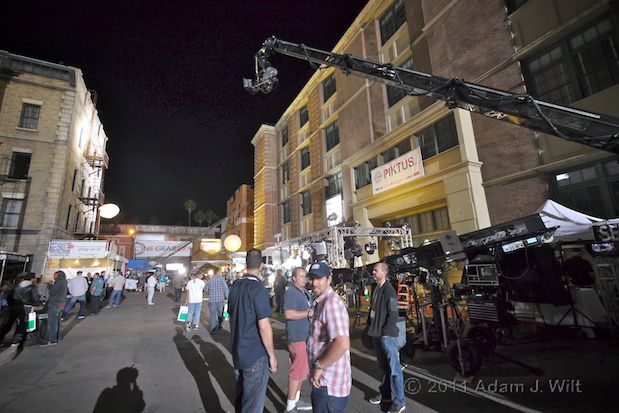
…and as high as you get a light, you can crane a camera higher.
The nighttime hours allow production folks busy during the day to visit, and also let lighting companies strut their stuff.
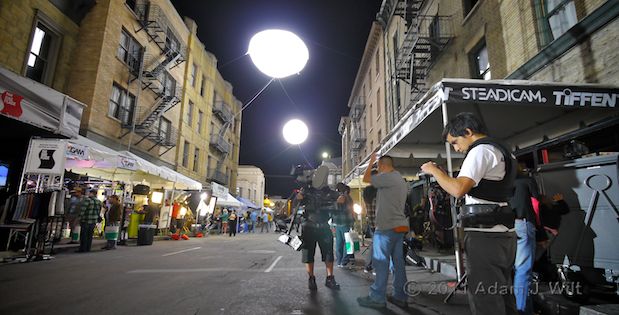
Just before closing on Friday was the best time to try on a Steadicam.
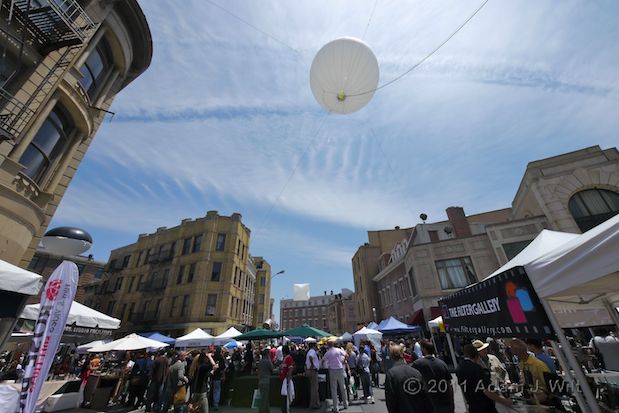
The crowds in this daytime shot are more typical; it’s a popular show.
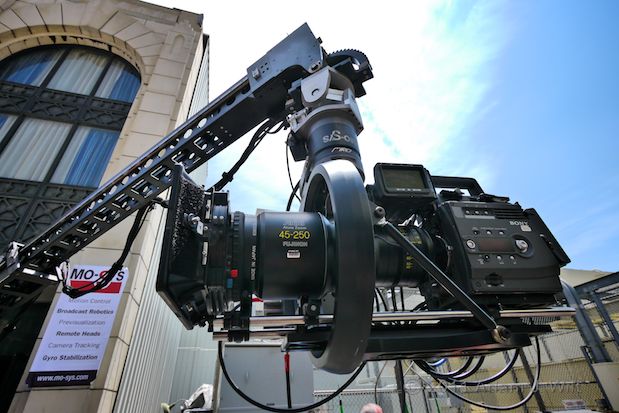
F35 and Alura zoom on a MoSys gyro-stabilized motion-control crane.
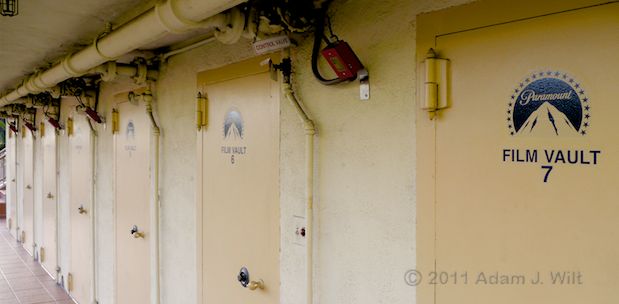
What bits of cinematic history lie behind these doors?
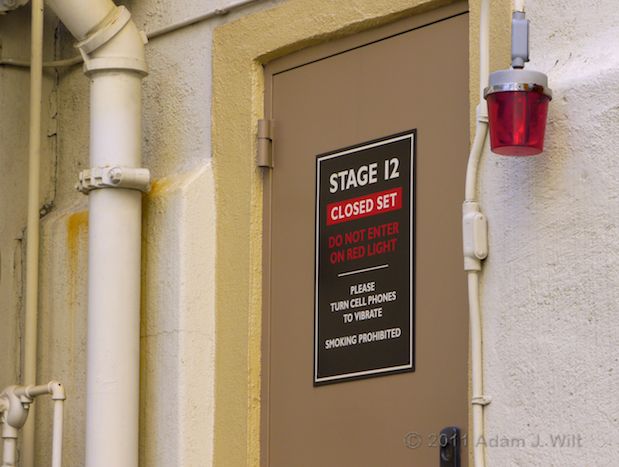
Woe betide the color-blind… or the blindly unobservant.
(For you east-coasters bemoaning the tyranny of distance, fear not: Cine Gear Expo NY will be in Manhattan September 24-25.)
And now, on with the show…
LEPs: Tesla Triumphant
Light-emitting plasma (LEP) is the latest lighting tech making waves [radio waves, actually] in motion picture production: a daylight-balanced, flicker-free, broad-spectrum source with high efficiency and long life. LEPs work by blasting noble gases and metal halides with focused radio-frequency energy, turning the mixture into a light-emitting plasma—an idea first proposed by Nikola Tesla. We saw the Photon Beard Nova 270 LEP at NAB, and Cine Gear offered up three new entrants into market.
HIVE Lighting has hexagonal, stackable LEP Fresnels; a 6K-equivalent spacelight drawing a mere 825 watts, and plasma retrofit kits for existing tungsten instruments. The fresnels are in the $5,000 range. HIVE is a new company and Cine Gear was their first show; their website has specs (including colorimetry data) for their current offerings as well as descriptions of future products.
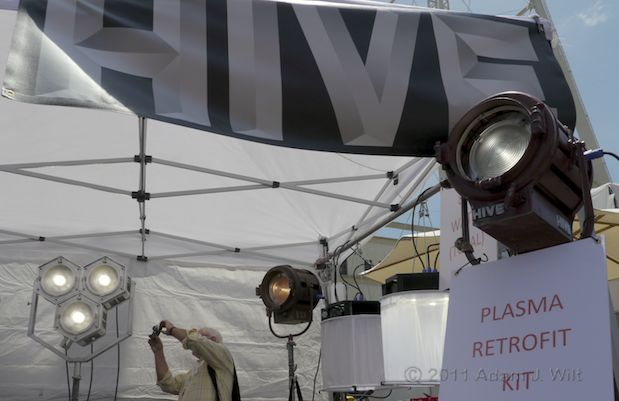
HIVE’s stand, with Fresnel, spacelight, and retrofits.
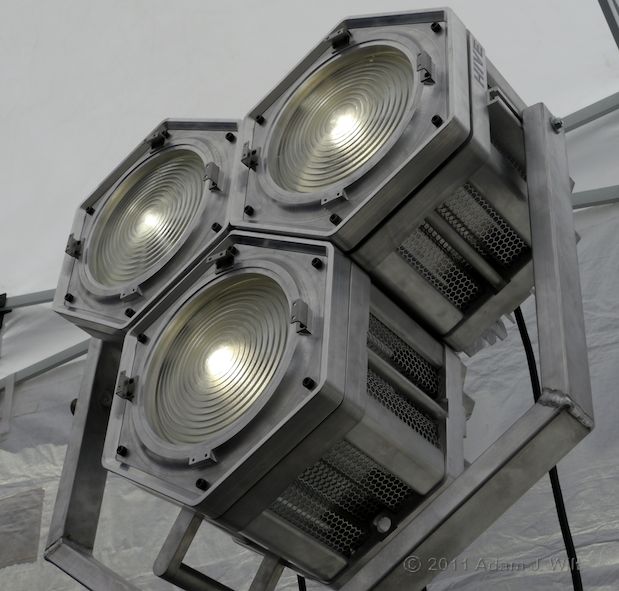
“Hornet” fresnels fit together in honeycomb formations.
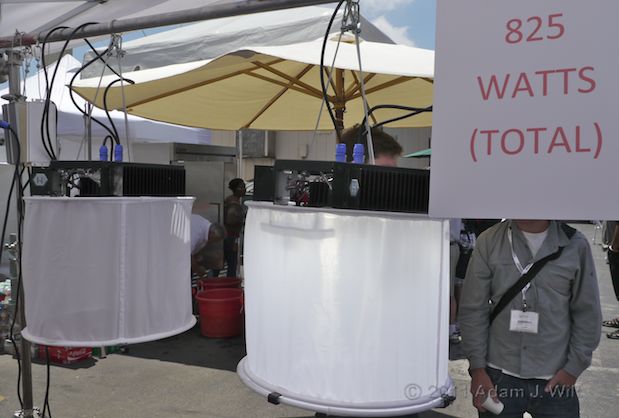
“BumbleBee” spacelights: 6kW’s worth of light on 0.8kW of power.
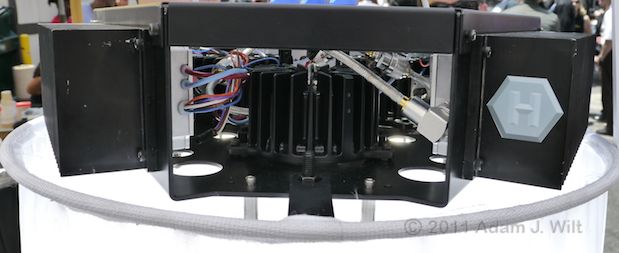
Three LEP “pucks” and ballasts in the BumbleBee head.
SeaChanger comes to mopix from the stage / venue / theatrical world; their Nemo and Nautilus LEPs are DMX-controllable instruments with ND-based dimming (to avoid the blue shift that occurs when dimming LEPs directly) as well as filter-wheel and dichroic-disk color changers for fine-tuning color rendition or throwing dramatic washes of color over a scene. They even have reworked Source Fours, combining the efficiency and spectrum of LEPs with the Source Four’s extreme controllability. These instruments are in the $3,000 range and up.
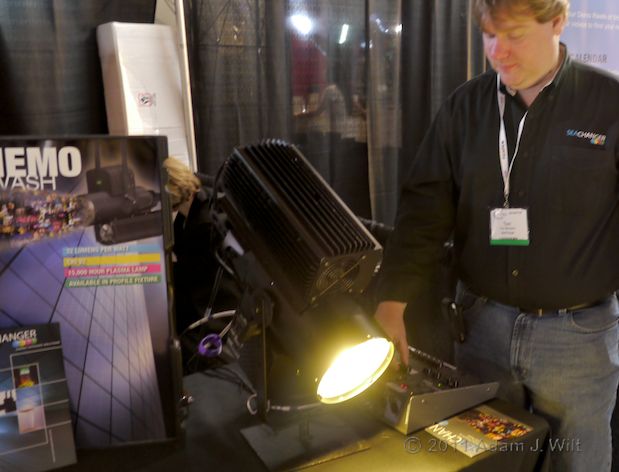
SeaChanger’s Tom Stanziano demos Nemo Wash color control via DMX.
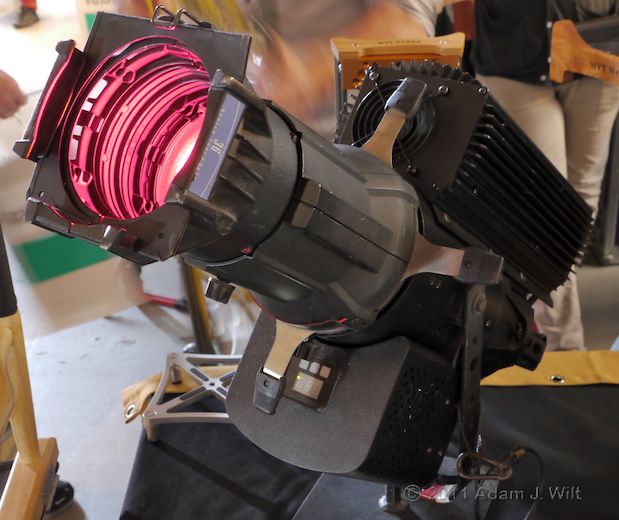
SeaChanger’s Nemo Profile, a “relamped” Source Four.
For those with more ambitious needs, Multiquip’s H2LT Hydrogen Fuel Cell Light Tower (seen lurking behind the “Welcome to cinegear” balloon in the first night shot above) combines multiple LEP heads on an extendable tower with a 5 kW hydrogen fuel cell generator on a trailer, letting you light up night exteriors without AC power, engine racket, or diesel fumes. Sorry, I didn’t get a price for it.
All these instruments are based on Luxim’s “LiFi” engine; Luxim’s website has lots of useful info on the technology. Where these LEPs differ is in their implementations: their reflectors, lensing, user controls, and housings.
While I was as the HIVE stand, a chap with ASC on his nametag came by to look, and talked about shooting in Europe in the ’90s with an earlier-generation LEP product, characterized as “a golf ball on a stick.” He praised the quality of the light, its controllability and color rendering. Other ASC folks were poking and prodding the gear, and waxing enthusiastic about its prospects, and one highly-placed AMPAS fellow (speaking unofficially, of course) had good things to say about SeaChanger’s color rendition. Given the rather ambivalent reception given to fluorescent and LED lighting, I found this very encouraging; LEP’s future is not only bright, but color-accurate and energy-efficient as well (and, as someone whose day job involved REDs and greenscreens, I highly approve of its native daylight color temperature!).
Cameras: Faster (fps), Smaller (size), Bigger (sensors), and Cheaper
P+S Technik introduced the PS-Cam X35, a 35mm-sized-sensor 1080p production camera capable of shooting from 1fps – 450fps. It works as a standard HD-SDI camera at frame rates from 24-60fps, and has 9, 18, or 36 GB of onboard buffer for high-speed acquisition: the 18GB model captures 4 minutes of 10-bit, 4:2:2 uncompressed Rec.709 material at 24fps, 41 seconds at 150fps, or 12 seconds at 450fps, and then plays it back over 3G HD-SDI.
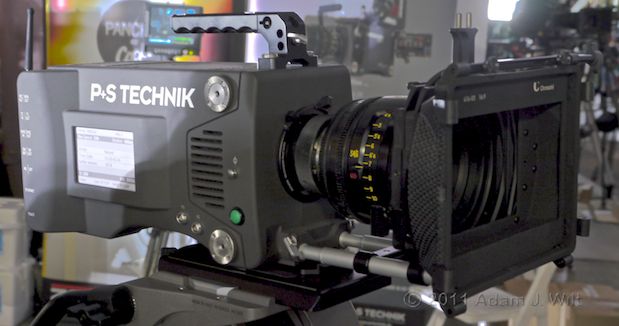
It’s a production camera and a high-speed camera combined.
The camera itself looks like a fat Alexa. It’ll weigh about 8.5 kg (19 pounds), and it’ll work like any other large-sensor production camera: timecode, genlock, audio, etc. It’s rated at about EI 640 and should offer 10-11 stops of dynamic range. At about €64,000 (roughly $93,500) for the 18 GB model, it won’t be cheap, but it’s half the price of a high-speed cam like the Weisscam HS-2, and it does double-duty as both a high-speed cam (albeit with a max frame rate of 450fps) and a fully-capable production camera at normal frame rates.
P+S Technic screened an X35 demo reel; it looked pretty darned good (there was some minor aliasing on a few finely-detailed elements in one shot, but that may have been an artifact of the projection system). The demo clips and full specs are said to be available at http://www.pstechnik.de/ps-cam-x35/index.php, but I reproduce the preliminary spec sheet here for those (like me) who lack the requisite patience for the registration page on the X35 website:
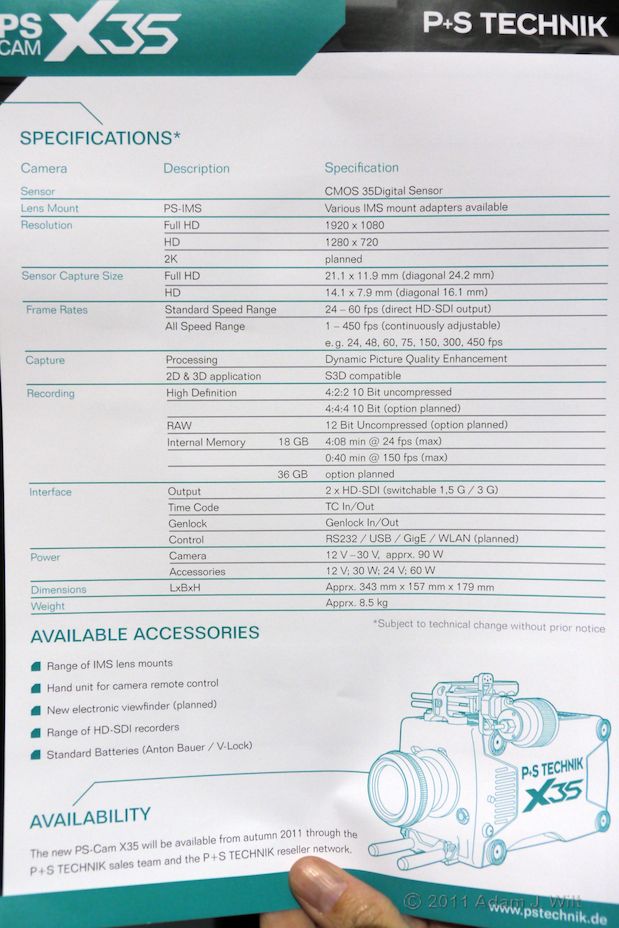
I should also mention the Weisscam T-concept, a modular camera system previously shown at Cinec 2010 and at NAB 2011. Watch the Flash animation on the website; it’s delightful and instantly informative.
JVC had a series of focus groups for their 4K camcorder (which was at the show on the same perforated metal box base shown in Jon Fauer’s photo in the link; the box contains a fan blowing cooling air into the exposed underside of this prototype camera. The camera’s “Falconbrid” processor can capture 3840×2160 at 24p, 30p and 60p; compress it to a 140 Mbit/sec h.264 datastream recorded across 4 SDHC cards in parallel; capture 4k JPEGS at 120fps (!) for 2-3 seconds; and provide realtime 4K monitoring / playback or a 2K downconvert, but it generates a lot of heat in the process, and JVC is still working on the best way to get rid of that heat). In the focus group I attended, we pretty much agreed that it’s not of much interest to broadcasters (at least not yet, grin), but for high-res stock footage and background-plate work, it’s very exciting.
JVC showed footage playing back from the camera, as they did at NAB. It looks very good indeed given the limits of a 4K camera that may sell in the $5,000-$11,000 range (actual price TBD). The highlights were a bit clippy and the lens showed some radial smearing at the periphery of the image (off-axis astigmatic aberration? Coma?), but resolution overall was stunning (bear in mind, this is from a small-format zoom lens focused on a 4K 1/2″ sensor) and compression artifacts were not apparent.
Sony showed off the F65, the F3, and the FS100. I saw Jim Rolin of San Francisco’s Videofax grilling a Sony rep mercilessly about F65 power consumption, monitoring LUTs, and the like; methinks the SF bay area will wind up with a resident F65 as soon as they’re available. I watched Mike Curtis’s F3 footage from the front row of the Paramount theater. It looked very nice—clean, noise-free, great tonal scale, naturalistic rendering—although as I had just come from pressing my nose up against the 4K monitor in the JVC exhibit, a mere 1080p image looked a little soft by comparison (grin). Juan Martinez presented the FS100, using basically the same slideshow he used for Sony’s own sales training (indeed, he edited the title live onscreen, changing it from “sales training” to “Cine Gear” as we watched), and had DP / doc filmmaker David Leitner along to show FS100 footage he shot and discuss it. David’s material was shot primarily with Sony G-series and Zeiss still-camera lenses via Sony’s Alpha-mount adapter; it consisted of beauty shots in and around New York City, and included timelapse and slo-mo material. It was all ungraded, straight-from-the-camera footage, transcoded to ProRes for editing and playback, and it all looked just fine, “despite” being 8-bit, Rec.709, 4:2:0 AVCHD material (oh, the horror!).
David considers the FS100 “a game changer”: the first really affordable, no-nonsense digital cine camera—a large-format, interchangeable-lens camera designed for motion picture work. When someone in the audience grumbled about the FS100’s lack of internal ND filters (which the FS100 lacks because there isn’t room behind the 18mm-deep E-mount), David countered, “How many cine cameras do you know of with internal NDs? No, not video cameras, cine cameras? This is a cine camera, make no mistake.”
Tessive’s Time Filter: the Most Significant Product at Cine Gear?
Startup company Tessive introduced the “Time Filter”, which may be nothing less than the most important advance in camera shutter technology since motion picture cameras were invented. Bold words, I know, but read on.
Digital cameras are often criticized for their sharp-edged motion portrayal, an artifact of their instant-on, instant-off shuttering. Film cameras usually use a mechanical shutter at some distance from the film plane; their shutters do not sharply and suddenly expose and then cover the film, but perform a soft-edged, “fade-in, fade-out” exposure due to their defocused, penumbral sweep across any given point on the film plane. 24p digital cameras with 180-degree shutters (or 1/48 sec shutters, if you prefer) tend to show more visible “stuttering” or “judder” on motion than film cameras do with the same shutter angle or time; the sharp-edged motion blur is the culprit. Some shooters try to compensate by opening the shutter longer, say, to 1/32 sec or 270 degrees. This increases the blur duration, partially (but only partially) compensating for the sharp edges, at the expense of increased blur overall.
Beyond that, all cameras using low frame rates (say, below 50 or 60 images / second) and any shuttering of less than the full frame or field duration show obvious and objectionable motion aliasing of the “backward wagon wheels” sort. This defect in motion rendering afflicts film and digital cameras alike; it’s exacerbated by slowing the frame rate down as well as shortening the shutter time within a frame’s duration (e.g., the duty cycle on-time).
What the Time Filter does, quite simply, is solve both these problems.
It’s the temporal equivalent of the spatial optical low-pass filter (OLPF) used on digital sensors to control aliasing: a temporal low-pass filter (TLPF) that takes the penumbral-sweep idea to its logical conclusion, a sinusoidal exposure profile:
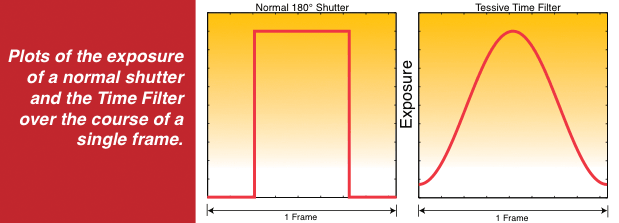
Graphic unabashedly stolen from Tessive’s downloadable brochure.
Any imaging geek reading this should be having the same reaction I had: it’s so obviously the Right Thing To Do, you’ll wonder why you didn’t think of it yourself.
Of course, all the really great inventions are blindingly obvious… once you’ve seen them.
The Time Filter is a front-of-the-lens active filter, currently available in 4×4 and 4×5.65 sizes, employing a variable-density LCD shutter synchronized with the camera.
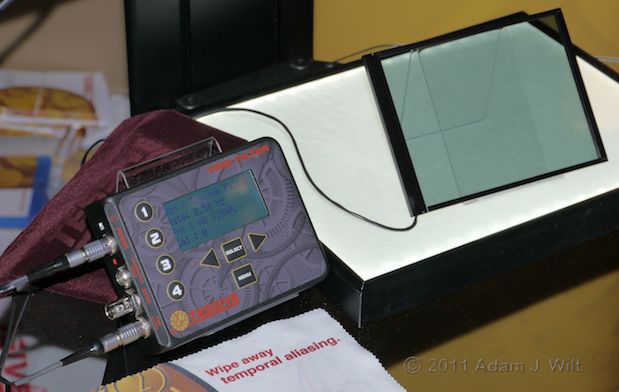
The Time Filter hardware: controller box and active LCD filter.
You plop the Time Filter in your matte box, set your shutter to 360 degrees (or 1/24th at 24p), genlock the Time Filter to the camera, and let the Time Filter work its magic of rendering motion that’s “simultaneously smoother and crisper—adjectives which are typically considered contradictory”, as Tessive puts it.
It works. Watch the demo clips on Tessive’s website. It’s subtle at times, but make no mistake: this is a watershed moment. One day, all cameras will be shuttered like this; today, the Tessive Time Filter is the first and only shutter designed to yield temporally-accurate images. Every shutter up ’til now has been built based on the mechanical and/or electronic requirements of the system it’s built into; the temporal artifacts in the movies we’ve all grown up with have been the incidental results of those designs. The Time Filter shutter gives us—for the first time ever—the same quality of temporal rendering at slow frame rates that we’ve had over the spatial rendering of our images, whether through the random grain structure of film, the gaussian scanning-beam tracks of tubes, or the OLPFs of well-designed solid-state sensors.
And as I think about it, I wouldn’t be the least bit surprised if the Time Filter shutter opens up the range of acceptable panning speeds for 24p production: those speeds too slow for complete motion blurring yet too fast for smooth motion fusion with conventional, temporally-aliasing shutters.
I can’t wait to see how this technology will expand the nature of what we can do.
Drawbacks? There are a few. You need a camera that outputs (or accepts) a genlock signal with a defined and consistent relationship to the actual frame times (thus, the 60i or 60p out of your Canon 5D Mk II while shooting 24p won’t work). The filter costs you about two stops of exposure. It adds a whole ‘nother set of batteries and cables and sync connections and is-it-turned-on checks that have to be dealt with on every shot. And if you need a shorter shutter time for a “Saving Private Ryan” look (assuming the Time Filter allows shorter duty-cycle on-times), you’ll lose the anti-backwards-wagon-wheels-aliasing action, even though you’ll retain the “penumbral sweep” smoother-and-crisper look. It probably won’t play well with RED’s HDRx.
Oh, and it costs $14,000, so for most of us it’s a rental item that, quite frankly, is going to be a hard sell to a skeptical and tight-fisted producer. Dang.
FTC Disclosure
I attended Cine Gear Expo 2011 on my own dime: I paid for my own transport, meals, and hotel, and I signed up in time for a free pass (I signed up as press, so I could take pictures and write about stuff, but that didn’t save me any money). I received no special consideration from Cine Gear Expo or any of the exhibitors; no material connection exists between Cine Gear Expo or any of the exhibitors and myself.

Filmtools
Filmmakers go-to destination for pre-production, production & post production equipment!
Shop Now